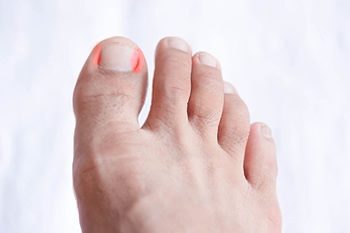
Ingrown toenails can cause significant discomfort, if left untreated. This condition develops when the edge of the toenail grows into the surrounding skin. People often notice redness and swelling surrounding the nail, along with tenderness when pressure is applied. Pain typically worsens when wearing shoes or walking for long periods of time. As the condition progresses, the skin near the nail may become warm and develop drainage or signs of infection. Some people may see pus or feel throbbing pain, especially if bacteria enters the area. The skin may also appear hardened or overgrown along the nail edge. Recognizing these symptoms early can help prevent more serious complications, including deeper infection or abscess. If you notice signs of an ingrown toenail, it is suggested you schedule an appointment with a podiatrist for proper care and appropriate treatment.
Ingrown toenails can become painful if they are not treated properly. For more information about ingrown toenails, contact Christian Smith, DPM of UTOEpia Foot and Ankle Specialist. Our doctor can provide the care you need to keep you pain-free and on your feet.
Ingrown Toenails
Ingrown toenails occur when a toenail grows sideways into the bed of the nail, causing pain, swelling, and possibly infection.
Causes
- Bacterial infections
- Improper nail cutting such as cutting it too short or not straight across
- Trauma to the toe, such as stubbing, which causes the nail to grow back irregularly
- Ill-fitting shoes that bunch the toes too close together
- Genetic predisposition
Prevention
Because ingrown toenails are not something found outside of shoe-wearing cultures, going barefoot as often as possible will decrease the likeliness of developing ingrown toenails. Wearing proper fitting shoes and using proper cutting techniques will also help decrease your risk of developing ingrown toenails.
Treatment
Ingrown toenails are a very treatable foot condition. In minor cases, soaking the affected area in salt or antibacterial soaps will not only help with the ingrown nail itself, but also help prevent any infections from occurring. In more severe cases, surgery is an option. In either case, speaking to your podiatrist about this condition will help you get a better understanding of specific treatment options that are right for you.
If you have any questions please feel free to contact our office located in Memphis, TN . We offer the newest diagnostic and treatment technologies for all your foot and ankle needs.
